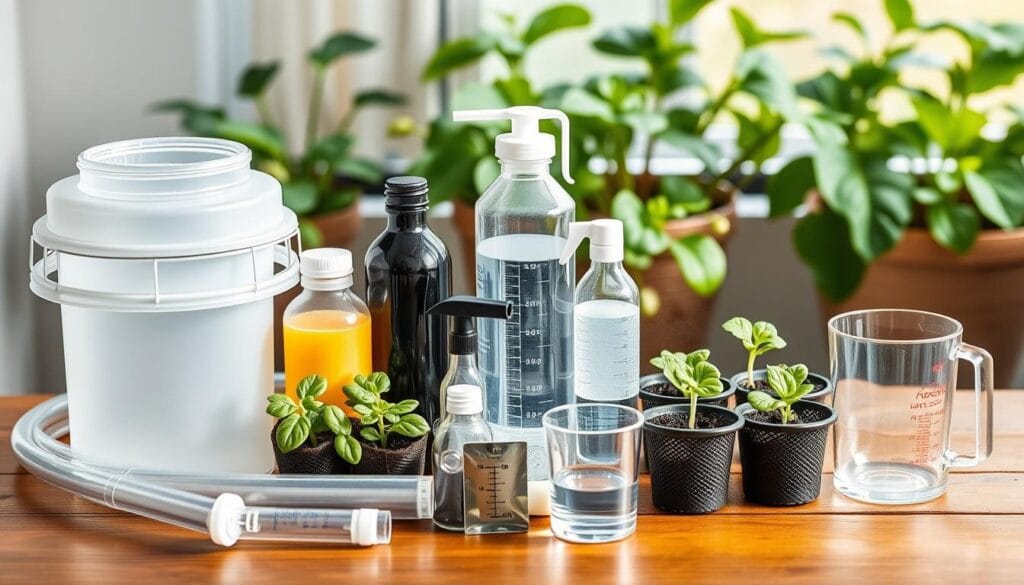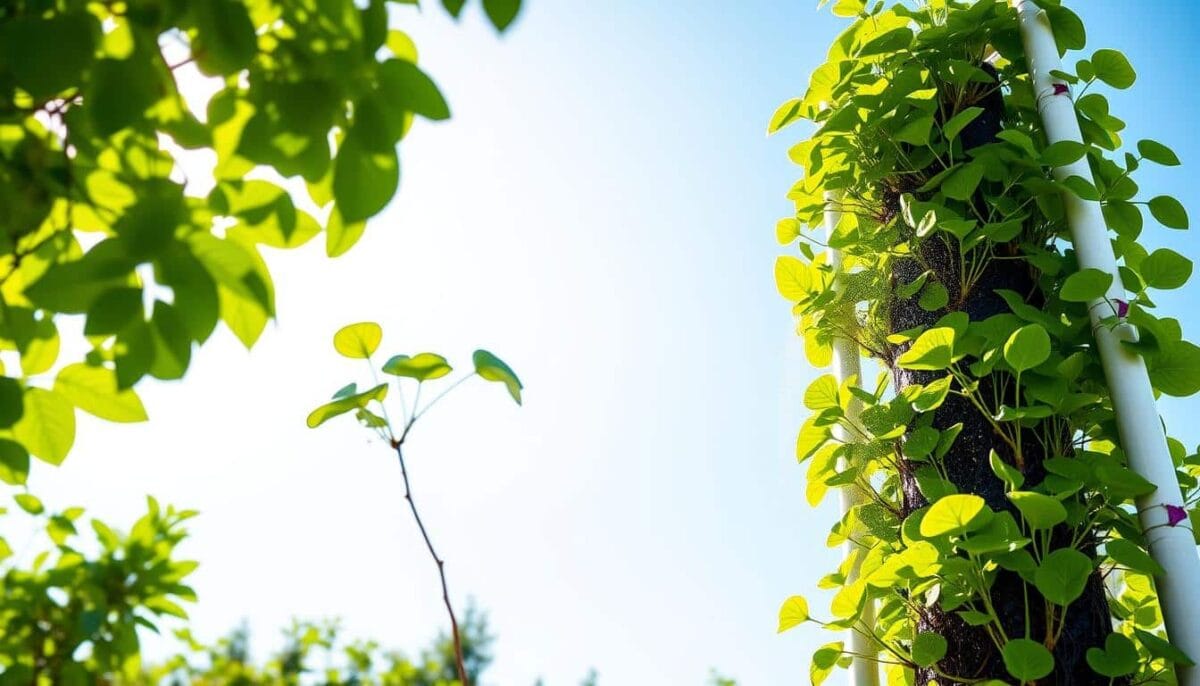DIY Aeroponics Tower has been a game-changer for me.I’ve always loved sustainability and being self-reliant. It lets me grow fresh, nutrient-rich produce at home.
In this guide, you’ll learn to make your own DIY aeroponics tower. It’s a way to grow plants in the air, saving space. This guide is for everyone, whether you’re new to gardening or have lots of experience.
Key Takeaways
- Discover the science behind aeroponics and its benefits for small-space gardening
- Learn how to design and construct a customized DIY aeroponics tower for your needs
- Understand the essential components and materials required for a successful setup
- Master the art of maintaining a thriving aeroponic system, from seed to harvest
- Troubleshoot common issues and optimize your tower for maximum productivity
Introduction to Aeroponics
Aeroponics is changing how we grow plants. It’s different from growing in soil. Aeroponics uses a mist of nutrients to feed plant roots in the air. It’s great for vertical farming and hydroponic gardening, making it easy to grow food in small spaces.
What is Aeroponic Gardening?
Aeroponic gardening grows plants without soil. Plants hang in the air, and their roots get misted with nutrients. This method saves space and water, perfect for today’s gardeners and farmers.
Benefits of Aeroponic Gardening
There are many good things about aeroponic gardening:
- It uses space well, especially in vertical farming setups
- It saves a lot of water, using up to 95% less than old methods
- Plants grow faster and produce more because they absorb nutrients better
- It keeps plants healthy by avoiding soil diseases and pests
Using aeroponics makes gardening more sustainable and productive. It’s great for city folks and experienced gardeners alike.
The Science Behind Aeroponics
Aeroponics is a unique way to grow plants. In an aeroponic system, roots hang in the air. They get misted with a nutrient-rich solution. This gives them oxygen, water, and nutrients directly.
This method helps plants grow faster and produce more than traditional gardening. It’s a big improvement over growing in soil.
How Aeroponics Works
Aeroponics uses a special growing chamber. Plants hang with their roots exposed. A high-pressure water pump sprays a nutrient-rich mist around them.
This mist keeps the roots wet and fed. It also lets the roots breathe oxygen. This boosts plant growth and health.
Essential Components of an Aeroponic System
- Reservoir: Holds the nutrient solution that is pumped through the system.
- Water Pump: Circulates the nutrient solution and creates the high-pressure mist.
- Misting Nozzles: Disperse the nutrient solution as a fine mist, ensuring even coverage.
- Timer: Automates the misting cycles, controlling the frequency and duration of the nutrient application.
- Growing Chambers: Provide a contained environment for the plants, suspending their roots in the air.
- Nutrient Solution: Formulated to provide the essential macro- and micronutrients required for plant growth.
These parts work together to give plants the best conditions. They get the right mix of oxygen, water, and nutrients. This leads to fast growth and high yields.
Aeroponics is changing the game in vertical hydroponics and urban farming. It’s a smart way to grow food in cities.
Planning Your diy aeroponics tower
Before starting your DIY aeroponics tower project, planning is key. You might want to grow food in a small space or try urban farming. A good plan leads to a successful aeroponic setup.
First, think about the space you have. Aeroponics towers fit well in small areas. Measure your space and consider any obstacles that might affect the tower’s placement.
Then, choose the plants you want to grow. Aeroponics works for many plants, like greens, herbs, and fruits. Learn about the needs of your plants to make sure your tower fits them.
Decide if your diy aeroponic tower will be indoors or outdoors. This choice affects the lighting and tower design. Indoor setups might need grow lights, while outdoor ones use sunlight.
Also, think about your budget and the materials needed. Aeroponics systems use common parts, but you’ll need to invest in pumps and misting systems.
Lastly, consider how easy it will be to access and maintain your vertical gardening design. Make sure the tower is easy to get to for plant care and adjustments.
With careful planning, your diy aeroponic tower will become a thriving garden. It will be efficient with space and give you the joy of urban farming.
Materials Needed
To create your own aeroponic tower, you’ll need some key aeroponic system materials. You’ll need strong PVC pipes or similar to build the tower. Also, you’ll need growth chambers like net pots for your plants.
You’ll also need misting nozzles, a reliable water pump, a nutrient solution reservoir, a timer, and tubing to connect everything.
Essential Components
The main parts for your DIY hydroponics supplies are:
- Vertical tower structure (such as PVC pipes)
- Growing chambers (e.g., net pots)
- Misting nozzles
- Water pump
- Nutrient solution reservoir
- Timer for automated misting
- Tubing to connect the components
Optional Accessories
To make your vertical garden equipment and hydroponic tower components even better, consider these optional items:
- Support frame for the tower
- Grow lights for extra light
- pH testing kit to check nutrient solution levels
With these key and optional parts, you’re ready to start building a aeroponic system. It will help you grow fresh produce right at home or in your urban garden.

Step-by-Step Guide to Building Your Tower
Building your own diy aeroponic tower is rewarding and saves space. It can also give you a lot of harvest. Let’s go through the steps to make your vertical hydroponics project come to life.
Prepare the Reservoir
Begin by setting up the reservoir for the nutrient-rich water. Pick a strong, food-grade container with a tight lid to keep it clean. Place the reservoir where you can easily check and adjust it.
Install the Pump and Misting System
Then, put in the water pump to move the nutrient solution. Connect the pump to the reservoir and set up the misting system. This system will spray the plant roots with the solution at set times.
Assemble the Growing Chambers
Finally, build the growing chambers for your plants. Use items like plastic bottles, gutters, or PVC pipes for the tower. Arrange the chambers to use space well and help your plants grow best.
By following these steps, you’ll be on your way to a thriving diy aeroponic tower. It will give you a lot of harvest and is good for the planet.
Setting Up the Nutrient Solution
Getting the right nutrients is key for your aeroponic tower’s success. You’ll need to mix the perfect aeroponic nutrient solution. Follow the manufacturer’s guide for the right amounts of macro- and micronutrients.
Understanding Nutrient Requirements
Plants in an aeroponic system need different nutrients than those in soil. The solution must have a balanced mix of nitrogen, phosphorus, potassium, calcium, magnesium, and micronutrients. It’s important to check and adjust the nutrient levels and pH often. This keeps your plants healthy and growing well.
| Nutrient | Role in Plant Growth | Recommended Concentration |
|---|---|---|
| Nitrogen (N) | Promotes foliage and stem development | 100-200 ppm |
| Phosphorus (P) | Supports root growth and flowering | 50-100 ppm |
| Potassium (K) | Enhances disease resistance and water regulation | 100-200 ppm |
| Calcium (Ca) | Strengthens cell walls and promotes overall plant health | 50-100 ppm |
| Magnesium (Mg) | Plays a crucial role in chlorophyll production | 20-40 ppm |
By watching and tweaking the nutrient levels and pH, you can give your aeroponic plants the best nutrients. This leads to strong growth and plenty of harvests.

Planting and Maintenance
Putting your plants in the aeroponic tower and keeping the aeroponic system running well are key for a good harvest. You’ll learn how to start your seeds right and move them to the growing chambers. This ensures their roots get the most from the misting system. You’ll also get tips on monitoring the system, checking the roots, and adjusting the misting or nutrients as needed. This keeps your aeroponic plants healthy and growing strong.
Starting Your Seeds
To start your aeroponic garden well, follow the best steps for hydroponic seed starting. First, pick high-quality, aeroponic-friendly seeds that fit your growing space. Use a clean, soilless mix for starting seeds and follow the packet’s instructions. When the seedlings have their first true leaves, it’s time to move them to the aeroponic tower.
Monitoring and Adjusting
- Check the roots of your aeroponic plants often to make sure they’re healthy and getting enough mist.
- Watch the pH of your nutrient solution, keeping it between 5.5 and 6.5 for the best aeroponic plant care.
- Change the misting schedule as needed to keep the right moisture levels and avoid root rot or other problems.
- Be quick to spot and fix any pest or disease issues to keep your vertical garden healthy.
By monitoring and adjusting your aeroponic system closely, you can make sure your plants get the best growing conditions. With the right care, your DIY aeroponics tower will give you a steady supply of fresh, healthy food right at your fingertips.
Troubleshooting Common Issues
Even the best aeroponic system can face problems. This section covers common issues like nutrient deficiencies, root rot, algae buildup, and misting system malfunctions. You’ll learn how to spot and fix these problems, keeping your hydroponic tower healthy and productive.
Nutrient imbalance is a common problem in vertical garden systems. It’s important to have the right mix of nutrients like nitrogen, phosphorus, and potassium for plant growth. If plants are not growing well or have discolored leaves, it might be time to adjust the nutrients. Look at a nutrient guide or ask experienced aeroponics gardeners for help.
Root rot is another issue, caused by too much moisture or poor air circulation. Make sure your misting system works well and water drains properly. If you see signs of root rot, quickly remove bad roots and adjust the water flow and air.
Algae in the reservoir can also be a problem. It can block the misting system and take nutrients from your plants. Keep the reservoir clean and dark to prevent algae.
Watch your misting system for any problems. Clogged nozzles or pump failures can harm plant growth. Fix any issues quickly and replace broken parts to keep your aeroponic system running smoothly.
By solving these common aeroponics problem solving issues, you can keep your hydroponic tower thriving. Enjoy a rich harvest all year round.
“Properly troubleshooting and maintaining your aeroponic system is the key to a successful vertical garden.”
Conclusion
Building your own aeroponic tower is a rewarding and efficient way to grow organic produce at home. Even in limited spaces, you can have a thriving vertical farm. Follow the steps in this guide to create a system that maximizes your resources.
Start growing your own food today and enjoy the diy aeroponics benefits.
The vertical farming advantages of aeroponics are clear. It uses less water, grows plants faster, and can be densely cultivated. This makes it perfect for urban gardeners and those with little outdoor space.
Aeroponics also helps the environment by using less water and reducing chemical runoff. It’s a great addition to your home hydroponics setup.
Whether you’re new to gardening or have experience, this guide will help you. It covers urban gardening techniques to empower you to grow your own food. Take control of your food supply and enjoy the benefits of aeroponic gardening.
Unlock your growing space’s full potential. Start your journey to self-sufficient, healthy living with your own DIY aeroponics tower.

